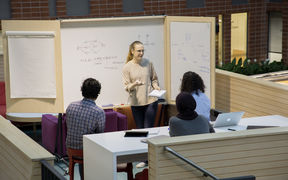Algorithms make information displays more interesting
Researchers at Aalto university have modeled how users’ eyes move across a display showing multiple content simultaneously, in a bid to make information systems more interesting for users. The model is based on the information foraging theory, which characterizes animals search for food.
The theory focuses on assessing the cost and benefit of users looking for information. The cost is the time spent on looking at different information sources, whereas the benefit is the gain obtained once the information goal is achieved. Maria Montoya Freire, the doctoral student behind the work, describes it using an analogy in nature. “A wolf can choose between hunt rabbits or deer: rabbits are easier prey, but deer offer more energy when eaten. Indeed, the best choice for the wolf is decided by calculating how much energy it can obtain for a given amount of time spent hunting.”
Likewise when looking at a display, users will try to get the most information out of the screen for the least amount of time they have to spend on each content item. They can choose to stop looking at the screen if the content displayed requires long time to be read or does not provide valuable information in the available time. By modelling this behavior mathematically, researchers were able to optimize the displayed content.
To validate their model, they ran an experiment and compared their optimized system against a typical slideshow. The experiment took place in the lobby of the Computer Science building for a month. Data collection leveraged a Kinect to track the time spent by users looking at the screen. The findings showed that the proposed system almost doubled the number of people that looked at the screen as they walked passed, compared to the typical solution. Similarly, more people stopped to read the content on the screen.
The researchers hope that their research could be used to help improve public services, like the screens at metro stations and airports.
“We have demonstrated the applicability of the information foraging theory in the design of pervasive displays solutions. As such, it is a starting point to further explore its use in this context. In the future we aim at improving the model predictions by considering other approaches such as the use of gaze-tracking data or the use of cognitive models.”
More information about the research is available at the following link https://doi.org/10.1016/j.pmcj.2019.02.008
Contact details:
Maria Montoya Freire
Department of Computer Science
Aalto University
[email protected]
Professor Mario Di Francesco
Department of Computer Science
Aalto University
[email protected]
Professor Antti Oulasvirta
Department of Communications and Networking
Aalto University
[email protected]
Department of Computer Science
cs.aalto.fi

Read more news

DeployAI Partners Gather for Heart Beat Meeting in Helsinki
The European DeployAI project's partners gathered for the Heart Beat meeting hosted by Aalto University Executive Education in Helsinki.
Get to know us: Associate Professor Maria Sammalkorpi
Sammalkorpi received her doctorate from Helsinki University of Technology 2004. After her defence, she has worked as a researcher at the Universities of Princeton, Yale and Aalto.
Aalto computer scientists in ICML 2024
Computer scientists in ICML 2024